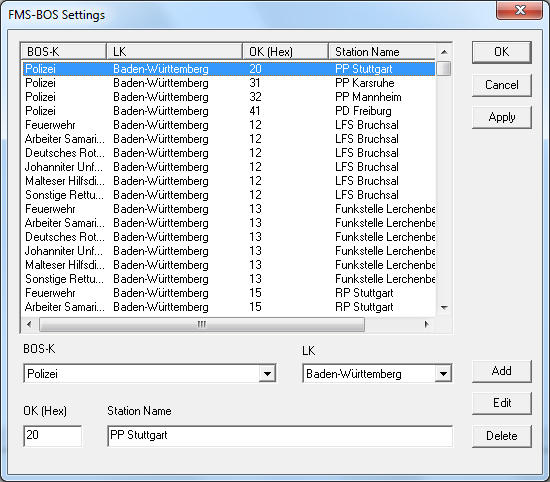
FMS-BOS is a radio signaling system for security authorities and organizations. The system allows for a major reduction in message interchange between mobile units and a control center by digital transmission of abbreviated telegrams.
|
Parameter |
Value |
|
Frequency range |
VHF |
|
Operation modes |
Simplex |
|
Modulation |
FM, SUB FSK |
|
Symbol rate |
1200 Bd |
|
Receiver settings |
FM, BW = 12 kHz |
|
Input format(s) |
AF, IF |
|
Additional Info |
BCD-Code with block coding |
FMS-BOS operates at 1200 bit/s using FSK modulation of 1200 Hz and 1800 Hz tones.
FMS-BOS Transmission Example

The FMS-BOS data telegrams always have the same structure and a length of 48 bits regardless of the transmission direction or message contents. The actual information is contained in 40 bits. The BCD code is used to transmit the digits in the telegram.
A FMS-BOS message is preceded by 12 bits of carrier and a sync character (0x1a).
The message itself consists of 10 BCD blocks.
Block 1 is the BOS service identifier (0...f) identifying the service issuing the message.
Block 2 is the state identifier (0...f) identifying the German state. Due to the fact that the number of states exceeds the number of available identifier digits, digits E and F are additionally identified by the location identifier to be used by two states each.
Blocks 3 - 4 are the location identifier (e.g., OK 10) and can assume one of 99 different possibilities. The actual value is determined by each individual state.
Blocks 5 – 8 are the vehicle identifier (e.g., 4213) and can contain one of 9999 combinations. The individual identifiers are assigned by each specific service.
Block 9 is the status field contains the actual information. 16 different messages may be transmitted. Depending on the R direction bit status messages attain different meanings. Furthermore the actual meaning of a status message is determined by the service and the individual states.
The last block 10 is mapped to 4 bits in the telegram and serves to communicate the equipment capability (B, bit 1), direction (R, bit 2) and abbreviated tactical information (X, Y, bits 4 – 5).
B
0 – Vehicle – dispatcher communications only
1 – Duplex communications possible
R
0 – Vehicle – Dispatcher
1 – Dispatcher – Vehicle
XY
Locally defined
For data protection, a 7-bit Abramson code redundancy block is appended to the data block. This is followed by a single stop bit which is however not tested.
As FMS data messages does not carry a date-timestamp, this information is generated by the real-time clock of the decoder and output to screen as the first data field.
|
BOS-Identifier |
Character |
BOS-Identifier |
Character |
|
Police |
1 |
German Red Cross |
9 |
|
Federal Border Protection |
2 |
"Johanniter" First Aid Service |
A |
|
Federal Criminal Bureau |
3 |
"Malteser" Support Service |
B |
|
Catastrophe Protection Service |
4 |
Life saving organization |
C |
|
Customs |
5 |
Miscellaneous rescue services |
D |
|
Fire Brigade |
6 |
Civil protection services |
E |
|
Technical Support Service |
7 |
Remote command |
F |
|
"Arbeiter-Samariter" Federation |
8 |
|
|
|
State identifier |
Character |
State identifier |
Character |
|
Sachsen |
0 |
Rheinland-Pfalz |
A |
|
Federal |
1 |
Schleswig-Holstein |
B |
|
Baden-Wuerttemberg |
2 |
Saarland |
C |
|
Bayern I |
3 |
Bayern II |
D |
|
Berlin |
4 |
Mecklenburg-Vorpommern |
e (00 – 49) |
|
Bremen |
5 |
Sachsen-Anhalt |
e (50 – 99) |
|
Hamburg |
6 |
Brandenburg |
f (00 - 49) |
|
Hessen |
7 |
Thueringen |
f (50 – 99) |
|
Niedersachsen |
8 |
Rheinland-Pfalz |
A |
|
Nordrhein-Westfalen |
9 |
|
|
FMS-BOS Settings

To apply or manipulate the various FMS-BOS stations select Options/FM-BOS Settings…
A table of FMS-BOS users is stored in \config\FmsbosSettings.xml.